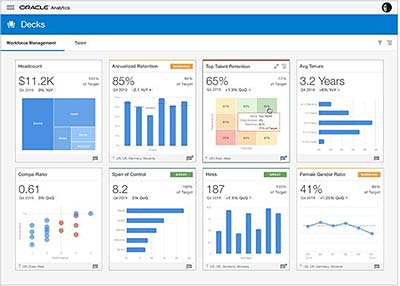Oracle Announces Oracle Analytics for Cloud HCM to Enable HR Teams to Enhance Decision Making, Boost Business Performance
- Oracle Analytics for Cloud HCM (Human Capital Managemen) brings ready-to-use workforce analytics to Oracle Cloud HCM customers
- New self-service analytics capabilities provide intuitive insights across a variety of areas including workforce composition, manager performance, span of control, diversity, turnover/retention, comparison ratio analysis, and top talent analysis.
Oracle today announced the availability of Oracle Analytics for Cloud HCM. Built on Oracle Analytics Cloud and powered by Oracle Autonomous Database, Oracle Analytics for Cloud HCM provides HR executives, analysts, and line-of-business leaders with deeper insights into workforce management by enabling a comprehensive view into data from across the organization. The new self-service analytics capabilities help customers maximize the value of Oracle Cloud HCM.
“In today’s volatile business environment, HR has become a key strategic business partner for the organization,” said T.K. Anand, senior vice president, Oracle Analytics. “With Oracle Analytics for Cloud HCM, customers are now able to leverage out-of-the-box HR analytics to gain unprecedented intelligence and reduce the organization’s reliance on IT. This allows for closer collaboration between HR and other key business units—such as finance—to help our customers navigate uncertain times and position them for sustained business growth.”
Built for HR Decision-Makers and Business Partners

Oracle Analytics for Cloud HCM includes the following pre-built features:
- Cross-functional data model: Accelerates analysis of large volumes of operational data within Oracle Cloud HCM. The data model resides within the high-performing, easy-to-use, and elastically scalable Oracle Autonomous Data Warehouse, enabling alignment across business functions.
- KPI and dashboard library: Delivers a rich set of more than 50 HR KPIs, dashboards, and reports for key HR metrics including workforce composition, turnover and retention, and team effectiveness to help HR teams gain faster insights. Pre-built KPIs include:
- Workforce demographics, span of control, and hire and promotion status
- Turnover (voluntary and involuntary) and retention
- Diversity statistics and trends
- Compensation trends and ratios
- Performance talent ratios
- Advanced analytics: Saves HR teams time, effort, and potential errors in calculations by analyzing key areas including:
- Top talent retention
- Turnover by compa-ratio
- Team effectiveness
- Span of control
- Diversity
- Extensibility to fit the business: Enables customers to augment Oracle Cloud HCM data with data from other Oracle applications, non-Oracle applications, or other external data sources.
“Organizations routinely report that utilizing cross-functional data delivers competitive advantage,” said Dave Menninger, SVP, Ventana Research. “Analytics based on a range of data that extends beyond the limits of the department—such as the capabilities in Oracle Analytics for Cloud HCM—enable line-of-business personnel to make decisions and take actions for the organization to best meet its strategic and operational objectives.”
“To deliver value, analytics must impact a business process. Analytic applications support business processes directly by delivering a variety of different types of analysis packaged as solutions targeting specific processes, and specific groups of business users. They cover various functions. Some support industry-agnostic business processes such as procurement, which some are industry-specific,” said Gartner analysts Alys Woodward and Gareth Herschel.
*Source: Hype Cycle for Back-Office Analytic Applications, 2019 (30 Sept 2019)
The latest offering in the Oracle Analytics for Fusion Applications suite, Oracle Analytics for Cloud HCM offers the same breadth of analytics capabilities added to Oracle Cloud ERP in September 2019. Oracle plans to continue enhancing the full suite of Oracle Fusion Applications with advanced analytics capabilities.

